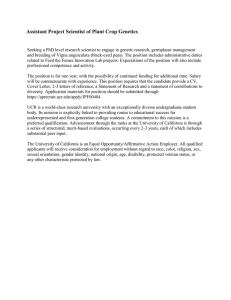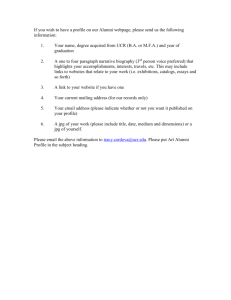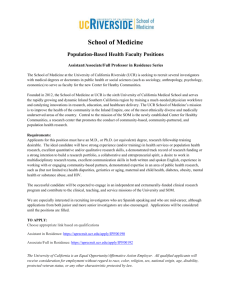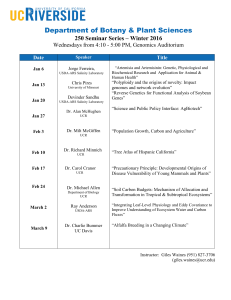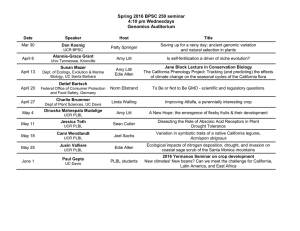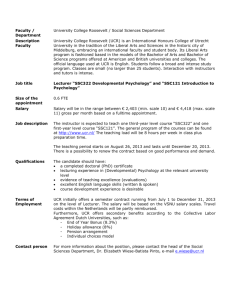Program News Section 1— Message To Program Participants
advertisement
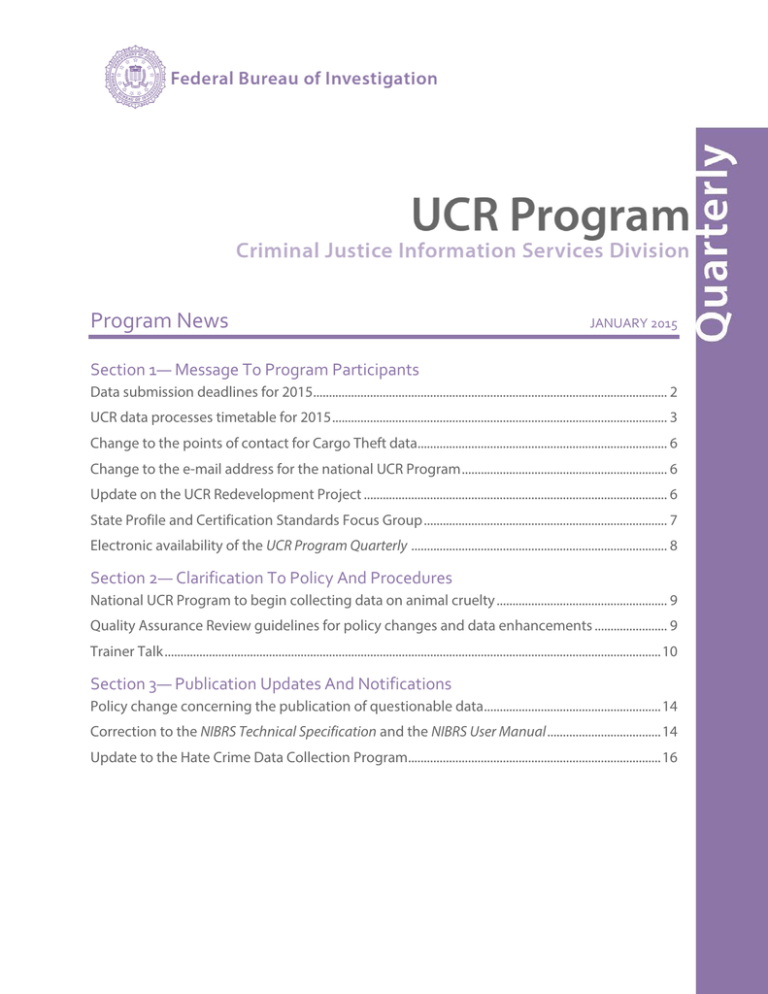
Program News JANUARY 2015 Section 1— Message To Program Participants Data submission deadlines for 2015................................................................................................................ 2 UCR data processes timetable for 2015 .......................................................................................................... 3 Change to the points of contact for Cargo Theft data............................................................................... 6 Change to the e-mail address for the national UCR Program ................................................................. 6 Update on the UCR Redevelopment Project ................................................................................................ 6 State Profile and Certification Standards Focus Group ............................................................................. 7 Electronic availability of the UCR Program Quarterly ................................................................................. 8 Section 2— Clarification To Policy And Procedures National UCR Program to begin collecting data on animal cruelty ...................................................... 9 Quality Assurance Review guidelines for policy changes and data enhancements ....................... 9 Trainer Talk ............................................................................................................................................................. 10 Section 3— Publication Updates And Notifications Policy change concerning the publication of questionable data........................................................ 14 Correction to the NIBRS Technical Specification and the NIBRS User Manual .................................... 14 Update to the Hate Crime Data Collection Program................................................................................ 16 Section 1— Message To Program Participants Data submission deadlines for 2015 State Uniform Crime Reporting (UCR) Program managers and direct contributors should note the following deadlines for data to be received by the FBI’s Crime Statistic Management Unit (CSMU). State Program managers should also inform their local agencies of these deadlines. Note: All state programs and direct contributors must submit data by established deadlines for publication. Although data received after the deadlines will not be published in the annual report(s), agencies are encouraged to forward the data for inclusion in the UCR Program’s master data files. Date Information needed March 13, 2015 Deadline to submit data for inclusion in the 2014 editions of Crime in the United States (CIUS), Law Enforcement Officers Killed and Assaulted (LEOKA), Hate Crime Statistics, and National Incident-Based Reporting System (NIBRS) to allow for data quality review, adjustments, and corrections. State UCR Program managers and direct contributors should note that: For agencies to be published in Tables 8-11 of CIUS, 2014, the CSMU must receive 12 months of complete data by the deadline. State totals presented in LEOKA, 2014, concerning the number of officers assaulted will include those law enforcement agencies for which the CSMU receives both 12 months of officer assault data and police employee counts. The number of quarters in which an agency reported hate crime data will be published in Tables 13 and 14 of Hate Crime Statistics, 2014. For agencies to be in the Offense Type by Agency Tables in NIBRS 2014, the CSMU must receive 12 months of complete NIBRS data and the agency must have been published in Tables 8-11 of CIUS. UCR Program Quarterly 15-1 2 January 2015 April 10, 2015 Final deadline to submit data for inclusion in the 2014 editions of CIUS, LEOKA, Hate Crime Statistics, and NIBRS. Data received between March 13 and April 10 may or may not be reviewed for quality, corrected, or adjusted depending on the extent of data quality issues; therefore, the data may or may not be published. The CSMU will not publish questionable data. Data received after April 10 will not be published; however, they will be included in the UCR Program’s master data files. September 11, 2015 Deadline to submit January through June 2015 data for inclusion in the Preliminary Semiannual Uniform Crime Report, January–June, 2015. December 18, 2015 Deadline to submit police employee counts as of October 31, 2015. December 31, 2015 Deadline for making changes to an agency’s name or address, for state UCR Program managers to add new contributing agencies within the state, or to change an agency’s current reporting status. UCR data processes timetable for 2015 Crime in the United States, 2014 Law Enforcement Officers Killed and Assaulted, 2014 Hate Crime Statistics, 2014 National Incident-Based Reporting System 2014 Preliminary Semiannual UCR, January–June, 2015 Month Work Process February‒ March The Operations Group of the CSMU sends e-mails to direct contributing agencies and state UCR Program managers: Requesting verification of any 2014 January‒December crime totals that indicate significant increases or decreases compared with the previous year’s data and/or verification of any high/low monthly offense count during the 12-month period. Identifying any 2014 January‒December data, by agency and month, that have not been received. Informing state UCR Program managers of the 2014 population estimates for agencies within their states. UCR Program Quarterly 15-1 3 January 2015 March The 2014 data submissions for inclusion in CIUS, LEOKA, Hate Crime Statistics, and NIBRS should be received by March 13, 2015, to allow for data quality review, adjustments, and corrections. Notes: CIUS, 2014–For agencies to be published in Tables 8-11, the CSMU must receive 12 months of complete data. LEOKA, 2014–Officer assault statistics are inclusive of those law enforcement agencies for which the CSMU receives officer assault data and police employee counts for all 12 months. Hate Crime Statistics, 2014–The number of quarters in which an agency reported hate crime data will be published in Tables 13 and 14. NIBRS 2014–For agencies to be included in the Offense Type by Agency Tables, the CSMU must receive 12 months of complete NIBRS data, and the agency’s data must have been published in Tables 8-11 of CIUS. April The final deadline for submitting data for inclusion in the 2014 editions of CIUS, LEOKA, Hate Crime, and NIBRS, is April 10, 2015. The CSMU Operations Group sends e-mails to agencies/state UCR Program managers providing 2014 January‒December crime totals/Return A Record Cards for all law enforcement agencies that submitted 12 months of complete data. May‒July The CSMU Operations Group sends e-mails to each direct contributor and state UCR Program manager providing his or her state’s 2014 violent crime and property crime counts that will be published in CIUS and includes the 2015 Publication Timetable. The CSMU Operations Group reviews for data quality and finalizes CIUS, LEOKA, and Hate Crime Statistics for publication. UCR Program Quarterly 15-1 4 January 2015 July‒August The CSMU Operations Group sends e-mails to each direct contributor and state UCR Program manager requesting missing 2015 January‒June data for Most in Population (MIP) law enforcement agencies for inclusion in Table 4 of the UCR Semiannual Report, January‒June, 2015. The e-mails remind contributors of the September 11, 2015, deadline for submitting data to be included in the UCR Semiannual Report, January‒June, 2015. The CSMU staff sends letters to those state UCR Program managers for which no 2015 data have been received and reminds them of the September 11, 2015, deadline for submitting data for inclusion in the UCR Semiannual Report, January‒June, 2015. The CSMU’s Operations Group sends e-mails requesting verification of any 2015 January‒June crime totals that indicate significant increases or decreases compared with the previous year’s data and/or verification of any high/low monthly offense count during the 6-month period for MIP agencies. September The deadline for submitting 2015 January through June data to the national UCR Program for inclusion in the UCR Semiannual Report, January‒June, 2015 is September 11, 2015. The CSMU’s Operations Group sends e-mails: Identifying, by law enforcement contributor, any 2015 January‒June data that have not been received by the September 11, 2015, deadline for inclusion in the UCR Semiannual Report, January‒June, 2015. Seeking follow-up from those agencies that did not respond to trend inquiries for the MIP agencies. (The Operations Group may opt to contact these managers via telephone.) Requesting verification of any 2015 January‒June crime totals that indicate significant increases or decreases from the previous year’s data and/or verification of any high/low monthly offense count during the 6-month period for all contributors other than MIP agencies that submitted 3 or more month’s data. October The CSMU’s Operations Group sends e-mails requesting the completion of information on current year’s police employee counts as of October 31, 2015. The deadline for submitting these data is December 18, 2015. The Multimedia Productions Group disseminates a UCR Program Quarterly newsletter reminding all agencies/state UCR Program managers of the December 31, 2015, deadline for making changes to an agency’s current reporting status, name/address, or for adding new contributing agencies within the state. (Assignment of an Originating Agency Identifier [ORI] will not be made until an agency submits one month of Return A data.) UCR Program Quarterly 15-1 5 January 2015 November The CSMU’s Operations Group sends e-mails to state UCR Program managers requesting review of the Population-by-County printout to verify current reporting status of each agency and to identify any new agency contributors. December The deadline for current year’s police employee counts to be submitted to the CSMU is December 18, 2015. Prior to the December 18, 2015, deadline, the CSMU’s Operations Group sends e-mails to remind direct contributors and state UCR Program managers that have not submitted police employee counts that the FBI has not received their police employee counts and inquires about police employee data that require state UCR Program manager’s review. The deadline for making changes to an agency’s current reporting status, name/address, or for adding new contributing agencies within the state is December 31, 2015. In December 2015, the CSMU staff will create the 2014 master files for summary and incident-based data; therefore, no additional 2014 data submissions will be processed. Change to the points of contact for Cargo Theft data The new contact for data submissions, verification, and missing cargo theft data in the CSMU is Ms. Jennifer K. Neely. Contributors may contact her by telephone at (304) 625-2959 or by e-mail at <jennifer.neely@leo.gov>. Issues involving statistical policies and/or outreach concerning cargo theft offenses should be directed to Mr. J. Mark Bush, who can be contacted by telephone at (304) 625-3503 or by e-mail at <mark.bush@ic.fbi.gov>. Change to the e-mail address for the national UCR Program Effectively immediately, the FBI’s UCR Program has a new e-mail address. State UCR Program managers and direct contributors are asked to discontinue the use of the <cjis_comm@leo.gov> e-mail address and, instead, use the new e-mail address <CRIMESTATSINFO@ic.fbi.gov>. Update on the UCR Redevelopment Project The national UCR Program staff continues to work on the UCR Redevelopment Project. Development of the “New UCR” system is taking place in five phases. Staff in the CSMU has reviewed the first two phases. A release date has not been established, but the “New UCR” system will be deployed in a two-step rollout process: an initial operational capability to be followed by a fully operational capability. UCR Program Quarterly 15-1 6 January 2015 Once fully operational, the “New UCR” system will feature: A centralized, searchable data repository at the CJIS Division in Clarksburg, West Virginia Capability to receive data submissions in a modern data specification An internal, web-based interface for users to access data An external, web-based portal to provide UCR data dissemination to law enforcement agencies and the public Hardware and software to support, integrate, and comply with CJIS systems Benefits of the “New UCR” system are: Electronic error reports sent directly to state systems Real-time intake of data and less manual entry for agencies Updated hardware and software for greater efficiency A streamlined publication process Specialized reporting on an as-needed basis The FBI will continue to keep UCR Program stakeholders apprised of the status of implementing the “New UCR.” Agencies with questions should contact the national UCR Program staff by telephone at (304) 625-4830 or by e-mail at <CRIMESTATSINFO@ic.fbi.gov>. State Profile and Certification Standards Focus Group In light of the changes anticipated with the future deployment of the “New UCR,” the UCR Subcommittee agreed with the national UCR Program to establish a focus group to create state profiles of each state’s UCR Program and to evaluate state UCR Program certification standards. The profiles will be used as a tool to assess each state’s strengths and weaknesses and to improve the validity of reported data. The profiles will also identify areas of concern in which states can assist each other. The FBI has assembled the recommended focus group. Members include representatives from the UCR Program Office, state UCR Programs, and the UCR Subcommittee. Focus group members have begun to identify elements for inclusion in the profiles and plan to have the task completed in mid-2015. The focus group decided that the national UCR Program will distribute profiles to each state’s UCR Program on a quarterly basis. Direct contributing agencies or individual agencies will not receive profiles. Also, with the UCR Subcommittee’s support, the national UCR Program will review and update certification standards under which a state program must operate. This action is particularly important with the upcoming deployment of the “New UCR” system. The national UCR Program’s current certification standards were last updated in 2012. UCR Program Quarterly 15-1 7 January 2015 Agencies with questions should contact Ms. Drema Fouch in the CSMU’s Programs Development Group. You can reach her by telephone at (304) 625-2982 or by e-mail at <drema.fouch@ic.fbi.gov>. Electronic availability of the UCR Program Quarterly The current UCR Program Quarterly, as well as previous editions, is available via the FBI’s Internet site at <http://www.fbi.gov/about-us/cjis/ucr/ucr-program-quarterly> and the UCR Program’s Special Interest Group (SIG) of the Law Enforcement Enterprise Portal (LEEP). To access the UCR Program Quarterly on the UCR Program’s SIG: Click on the LEO Special Interest Group icon under the Service column Scroll to the bottom of the page and click on the UCR logo Click on the UCR Program Quarterly folder Users with questions concerning access to the LEEP should contact the Online Services and Operations Unit by telephone at (304) 625-5555. UCR Program Quarterly 15-1 8 January 2015 Section 2— Clarification to Policy and Procedures National UCR Program to begin collecting data on animal cruelty Beginning January 1, 2016, the national UCR Program will add the offense of Animal Cruelty to the NIBRS as a Group A offense and as a Crime Against Society. Data Element 12 (Type Criminal Activity/Gang Information) will expand to include four data values about the type of abuse. The four types of abuse will be: Simple/Gross Neglect (failure to provide food, water, shelter, veterinary care, or intentionally or knowingly withholding food or water) Intentional Abuse and Torture Organized Abuse (dog fighting and cock fighting) Animal Sexual Abuse (bestiality). The definition of Animal Cruelty will be: Intentionally, knowingly, or recklessly taking an action that mistreats or kills any animal without just cause, such as torturing, tormenting, mutilation, maiming, poisoning, or abandonment. Included are instances of duty to provide care, e.g., shelter, food, water, care if sick or injured; transporting or confining an animal in a manner likely to cause injury or death; causing an animal to fight with another; inflicting excessive or repeated unnecessary pain or suffering, e.g., uses objects to beat or torture an animal. This definition does not include proper maintenance of animals for show or sport; use of animals for food, lawful hunting, fishing, or trapping. The national UCR Program staff will implement these changes to the NIBRS during the 2015 calendar year and will begin to collect these data on January 1, 2016. Agencies with questions should contact Ms. Drema Fouch in the CSMU’s Programs Development Group. You can reach her by telephone at (304) 625-2982 or by e-mail at <drema.fouch@ic.fbi.gov>. Quality Assurance Review guidelines for policy changes and data enhancements In the past several years, both the Summary Reporting System (SRS) and the NIBRS have undergone several changes: Expanded location and property data values in the NIBRS Revised definition of rape in the SRS Began the collection of cargo theft data and human trafficking data in both the SRS and the NIBRS. UCR Program Quarterly 15-1 9 January 2015 Because of these changes, the CJIS Audit Unit (CAU) and the national UCR Program Office have established a baseline for including new data collections or policy changes in the Quality Assurance Review (QAR) assessments of state UCR Programs and local law enforcement agencies. Currently, CAU staff conducts audits on a triennial cycle based on fiscal years that begin on October 1. However, UCR Program changes are typically implemented on January 1 of a calendar year. Since the QAR triennial cycle is based on a fiscal year, state UCR Programs and local law enforcement agencies will have a grace period of 3 years and 9 months to make changes to their reporting procedures and records management systems to meet UCR Program data collection enhancements or policy changes. As an example: Date Event January 1, 2013 National UCR Program began to collect human trafficking data October 1, 2013 Fiscal year 2014 QAR triennial audit schedule began October 1, 2016 Fiscal year 2017 QAR triennial audit schedule begins Auditors will assess UCR Program Office changes from January 1, 2013. This baseline will be enforced beginning with all 2013 initiatives, such as the revised definition of rape and human trafficking data. Any changes that the FBI implemented beginning on January 1, 2013, will not be included in a QAR until October 1, 2016 (the start of the 2017 fiscal year). During the grace period, the CAU staff will discuss recent policy changes and/or data enhancements with agency personnel for informational purposes and to maintain awareness of the new initiatives. Agencies with questions should contact Ms. Joyce A. Humphrey in the CAU. She can be reached by telephone at (304) 625-2920 or by e-mail at <joyce.humphrey@ic.fbi.gov>. Trainer Talk Each quarter, Trainer Talk features questions that the trainers from the national UCR Program have received about classifying and scoring offenses in the UCR Program. The trainers answer questions for both the NIBRS and the SRS. The information they provide is for UCR Program reporting purposes and may not reflect the manner in which an offender(s) is charged. When requesting the classification and scoring of incidents, law enforcement agencies and state program personnel are asked to provide the entire incident report so that the UCR trainers can provide the most accurate assessment. Agencies may submit incident reports by e-mail to <UCRtrainers@leo.gov> or by facsimile to (304) 625-5599. Agency staff with questions should contact the trainers e-mail at <UCRtrainers@leo.gov>. UCR Program Quarterly 15-1 10 January 2015 Question A victim reported that she was sexually assaulted by her stepbrother who forced her to perform fellatio and engage in vaginal intercourse. She indicated that her stepbrother did not physically threaten her or use physical force to make her engage in these acts. However, the victim said that he threatened to tell their parents about highly personal secrets she previously shared with him. Does this type of incident meet the new SRS definition of rape? Answer For SRS reporting agencies: The national UCR Program revised the definition of rape in the SRS in 2011 and began data collection under the revised definition in January 2013. The change to the rape definition only applied to the SRS because NIBRS already captures the broader sex offense information reflected in the new definition. In this instance, the victim was coerced into engaging in sexual acts by the offender; therefore, this incident should be reported as rape in the SRS. Physical resistance is not required on the part of the victim to demonstrate lack of consent. Question How should an agency report the arrest of a pilot who flew an airplane while intoxicated? Answer For both NIBRS and SRS agencies: The arrest of an intoxicated individual piloting an aircraft should be reported as a Driving Under the Influence (DUI). Although the SRS User Manual (Version 1.0 dated June 20, 2013) and the NIBRS User Manual (Version 1.0 dated January 17, 2013) do not specifically list operating an airplane, the proper reporting category for this type of offense is DUI, which is defined as “driving or operating a motor vehicle or common carrier while mentally or physically impaired as the result of consuming an alcoholic beverage or using a drug or narcotic.” This offense includes driving while intoxicated and operating a bus, train, streetcar, boat, etc., while under the influence. SRS agencies should count an arrest on the Age, Sex, Race, and Ethnicity form when the offending individual is arrested, cited, or summoned for the violation of DUI. Agencies that report data via the NIBRS are required to submit a Group B arrest record using the offense code of 90D (Driving Under the Influence) for Data Element 45 (UCR Arrest Offense Code). Question An individual shoplifted from a retail establishment, was charged with trespassing on the property, and was formally advised that the individual was no longer allowed to enter the establishment. The person tried to reenter the establishment with the intent to shoplift. Should this offense be reported to the UCR as a burglary even though the offender was charged with shoplifting? Answer For both NIBRS and SRS agencies: Three elements must be met for the definition of burglary: 1) it must be a structure, which is defined as four walls, a roof, and a door, 2) there must be trespassing or unlawful entry and 3) there must be the intent to commit a felony or a theft. UCR Program Quarterly 15-1 11 January 2015 The attempt to reenter the establishment should be reported to the UCR Program as a burglary. The fact that the offender trespassed and was banned from the retail establishment satisfies the unlawful entry of a structure portions of the definition of burglary. The remaining criteria were met as well. Therefore, the reported offense must meet the classification and scoring rules and definitions of the UCR Program regardless of the actual charge lodged by the law enforcement agency. Just as reporting agencies are required to report offenses uniformly, agencies are required to report arrests uniformly. Question How should theft of merchandise displayed outside a retail establishment be reported? The retail establishment was a garden center that had items outside of the building on display racks and tables. The thefts occurred during business hours. Answer For both NIBRS and SRS agencies: This type of incident should be reported as shoplifting. Page 33 of the NIBRS User Manual (Version 1.0 dated January 17, 2013) and page 47 of the SRS User Manual (Version 1.0 dated June 20, 2013) state that shoplifting includes “thefts of merchandise displayed as part of the stock in trade outside of buildings such as department stores, hardware stores, supermarkets, fruit stands, and gas stations.” A law enforcement agency will most likely charge the individual with an offense such as Larceny-Theft – All Other Larceny; however, this type of incident should be reported to the UCR Program as a shoplifting offense because the merchandise exposed or displayed for sale outside of the building meet the UCR conditions for shoplifting. Agencies that report data via the NIBRS should report the incident as 23C (Shoplifting) in Data Element 45 (UCR Arrest Offense Code); agencies that report data via the SRS should report the incident as a Shoplifting (6Xc) on the Return A form. Question regarding the correct property description for bank routing numbers and bank account numbers A victim advised she had received a letter in the mail from the Internal Revenue Service (IRS), which stated that she needed to send them a missing form in order process her tax return properly. A few days later, she received a telephone call from a person claiming to be from the IRS. This person requested her bank routing number and bank account number in order to withdraw a $200 fee for misfiling her taxes. The victim supplied the caller with the requested information. The victim then called her accountant and informed him of the situation. The accountant advised her to call her bank, cancel the transaction immediately, and to call the police. The police department compiled an incident report via the NIBRS and submitted the property loss (the bank routing number and bank account number) as 22-Nonnegotiable Instruments in Data Element 15 (Property Description). By definition, however, a nonnegotiable instrument requires further action to become negotiable, such as unendorsed checks, money orders, traveler’s checks, stocks, bonds, blank checks, etc. (See page 91 of the NIBRS User Manual, Version 1.0 dated January 17, 2013.) Auditors in the CAU and the UCR trainers discussed this choice in detail and concluded that the routing number was best described as 65-Identity Documents in Data Element 15 (Property UCR Program Quarterly 15-1 12 January 2015 Description). By definition, an identity document is a formal document and/or its number that provides proof pertaining to a specific individual’s identity, such as passports, visas, driver’s licenses, Social Security cards, alien registrations cards, voter registrations cards, etc. (See page 96 of the NIBRS User Manual, Version 1.0 dated January 17, 2013.) A bank routing number and bank account number can uniquely identify an individual and his/her bank. In addition, a bank routing number and bank account number are not instruments, whether negotiable or nonnegotiable. UCR Program Quarterly 15-1 13 January 2015 Section 3— Publication Updates And Notifications Policy change concerning the publication of questionable data The July 2014 UCR Program Quarterly (14-3) included the article “FBI is no longer accepting hard copy submissions for the Uniform Crime Reporting Program’s Summary Reporting System.” The third paragraph of that article stated: “If the national UCR Program staff identifies questionable data, UCR staff will send the questionable data to the state or agency for verification. If the national UCR Program staff does not receive a response from the contributor, the national Program will publish the data as reported.” However, the national UCR Program staff examined the policy, studied past practices, and decided to rescind the policy to publish questionable data if the national Program has not received a response. Effective immediately, the policy regarding questionable data is: “When the FBI’s UCR Program staff review and analyze data received from contributing agencies, all questionable data will be sent to the state/agency for verification. If no response is received from the contributor, the data in question will not be published.” Agencies with questions should contact the national UCR Program staff by e-mail at <CRIMESTATSINFO@ic.fbi.gov>. Correction to the NIBRS Technical Specification and the NIBRS User Manual The FBI’s UCR Program is making two corrections to the National Incident-Based Reporting System (NIBRS) Technical Specification, Version 1.1, dated September 17, 2014, and one correction to the National Incident-Based Reporting System (NIBRS) User Manual, Version 2.0, dated August 27, 2013. Information with strikeout should be deleted, and information in bold should be added. The following changes will be included when the NIBRS Technical Specification, Version 1.2, and NIBRS User Manual, Version 2.1, are released; however, a release date has not yet been determined. Once completed, both manuals will be available at <www.fbi.gov/about-us/cjis/ucr>. NIBRS Technical Specification, pages 20-21, addition of two Cargo Theft-related offenses 3.3.2.3 Data Element 2A-Cargo Theft This data element indicates whether or not the incident involved a Cargo Theft. Although it is an optional data element, once added to a submission, it becomes conditional and must be populated with a valid data value or left blank depending on the offenses in the incident. By incorporating the Segment Length of “0088” for Cargo Theft, incidents with a Cargo Theft-related UCR Program Quarterly 15-1 14 January 2015 offense must contain a valid data value in record position 88. Conversely, any incident without one of these offenses must contain a blank in position 88. Cargo Theft-related offenses are: • 120 = Robbery • 210 = Extortion/Blackmail • 220 = Burglary/Breaking & Entering • 23D = Theft From Building • 23F = Theft From Motor Vehicle • 23H = All Other Larceny • 240 = Motor Vehicle Theft • 26A = False Pretenses • 26B = Credit Card/Automated Teller Machine Fraud • 26C = Impersonation • 26E = Wire Fraud • 270 = Embezzlement • 510 = Bribery NIBRS Technical Specification, pages 65-67, clarification of BE relationship code Section 3.3.5.16 Data Element 35-Relationship of Victim to Offender Under the list of data values, BE = Victim Was Babysittee the Baby/Child in the Care of a Babysitter NIBRS User Manual, pages 120-121, clarification of BE relationship code Data Element 35 (Relationship of Victim to Offender), under the list of Outside Family But Known to Victim data values, BE = Victim Was Babysittee the Baby/Child in the Care of a Babysitter Agencies with questions should contact the CSMU by e-mail at <CRIMESTATSINFO@ic.fbi.gov>. UCR Program Quarterly 15-1 15 January 2015 Updates to the Hate Crime Data Collection Program The national UCR Program has modified the UCR hate crime data collection procedures to include all self-identified religions in the United States that are listed in the Pew Research Center’s Pew Forum on Religion and Public Life (2008) and the U.S. Census Bureau’s Statistical Abstract (2012). The Hate Crime Data Collection Program will also include an anti-Arab bias motivation. These modifications affect hate crime data whether submitted via the NIBRS or the SRS. Effective January 1, 2015, in addition to the current religious bias categories, agencies should also report the following religious bias categories: 28 = Anti-Mormon 29 = Anti-Jehovah’s Witness 81 = Anti-Eastern Orthodox (Greek, Russian, etc.) 82 = Anti-Other Christian 83 = Anti-Buddhist 84 = Anti-Hindu 85 = Anti-Sikh Also, beginning January 1, 2015, the national UCR Program is collecting race and ethnicity biases in a revised category of Race/Ethnicity/Ancestry. These biases will include (with the new category in bold): 11 = Anti-White 12 = Anti-Black or African American 13 = Anti-American Indian or Alaska Native 14 = Anti-Asian 15 = Anti-Multiple Race, Group 16 = Anti-Native Hawaiian or Other Pacific Islander 31 = Anti-Arab 32 = Anti-Hispanic or Latino 33 = Anti-Other Race/Ethnicity/Ancestry (This has changed from Anti-not Hispanic or Latino.) The national UCR Program has developed a new electronic Hate Crime Incident Report form, which was sent to contributing agencies on December 23, 2014, via e-mail. The form will be available soon at the Association of State Uniform Crime Reporting Program’s Web site at <www.asucrp.net>. In addition, the national UCR Program has updated the Hate Crime Technical Specification and the National Incident-Based Reporting System (NIBRS) Technical Specification to reflect recent changes UCR Program Quarterly 15-1 16 January 2015 to the Hate Crime Data Collection Program. These documents will be available soon at <www.fbi.gov/about-us/cjis/ucr/ucr-program-data-collections> and at <www.asucrp.net>. In addition, the national UCR Program has submitted the Hate Crime Data Collection Guidelines and Training Manual to the Office of Management and Budget (OMB) as part of the approval process. However, the national Program does not anticipate receiving final approval for the document until early 2015. Once the national Program obtains OMB approval, the national Program will disseminate the Hate Crime Data Collection Guidelines and Training Manual to all contributing agencies. Agencies with questions about the Hate Crime Statistics Program should contact Ms. Kristi L. Donahue in the Programs Development Group of the CSMU by telephone at (304) 625-2972 or by e-mail at <kristi.donahue@ic.fbi.gov>. UCR Program Quarterly 15-1 17 January 2015
